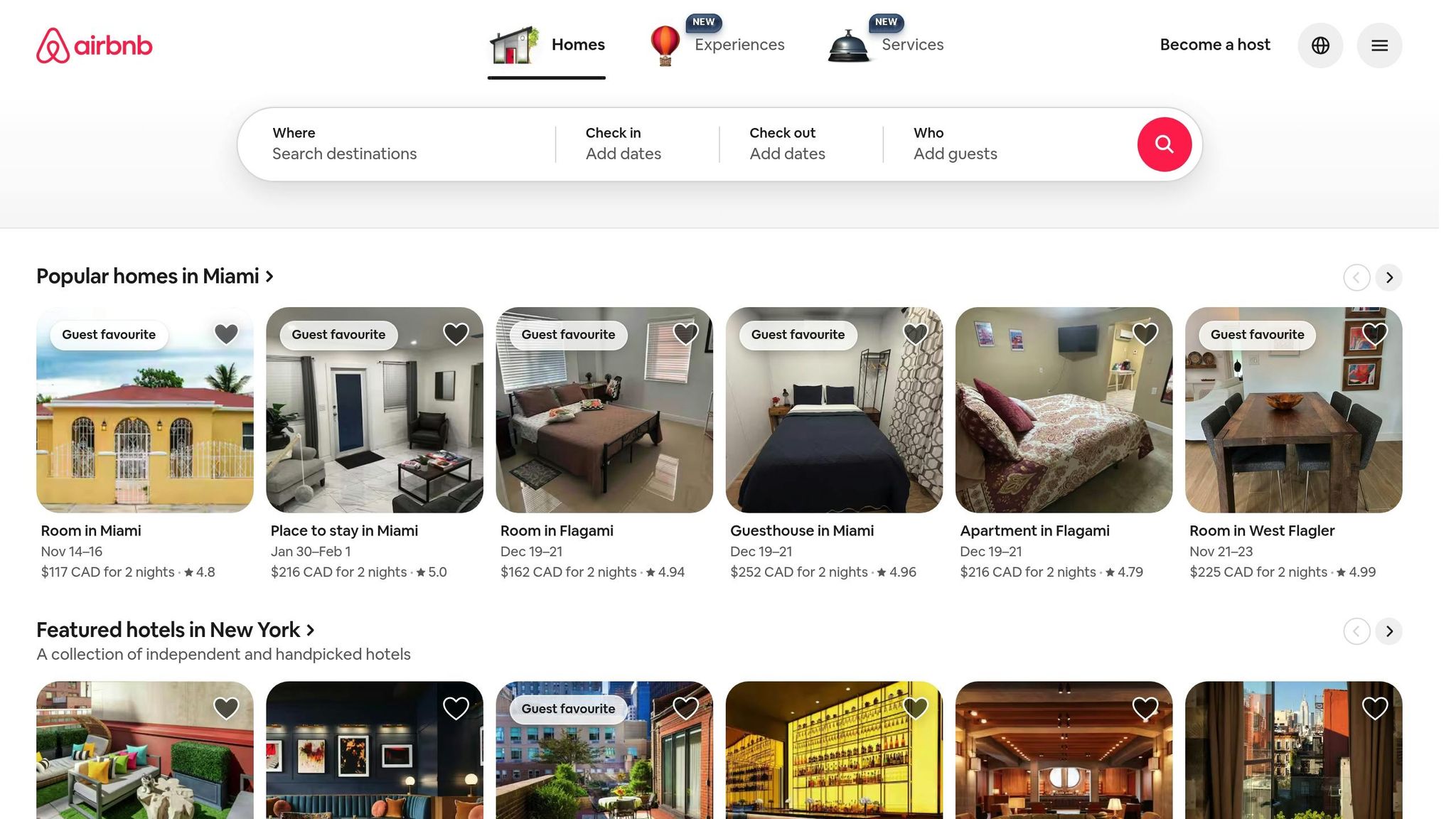Casa Scotia’s 21-day onboarding process is designed to help property owners in Nova Scotia launch short-term rentals quickly and effectively. It focuses on four main goals: meeting legal requirements, preparing the property for guests, creating a strong market presence, and setting up efficient management systems. Here's a quick breakdown of the process:
-
Week 1: Property Assessment and Compliance
- Inspect the property for safety and amenities.
- Handle provincial and municipal registrations, insurance, and permits.
- Ensure utilities and documentation are organized and accessible.
-
Week 2: Staging, Photography, and Inventory
- Professionally stage the property for appeal.
- Create a detailed inventory of guest essentials.
- Take high-quality photos to attract bookings.
-
Week 3: Marketing and Listing Setup
- Write engaging property descriptions and highlight unique features.
- Use dynamic pricing tools to adjust rates based on demand.
- Promote properties with a focus on Nova Scotia’s seasonal attractions.
-
Final Steps: Launch and Management Handover
- Conduct a final walkthrough to ensure guest readiness.
- Implement guest screening and communication protocols.
- Transition to full-service management, including cleaning, maintenance, and financial reporting.
This structured approach ensures properties are ready to attract guests while meeting all legal and operational requirements. Casa Scotia also provides ongoing support, allowing owners to focus on other priorities while maximizing their rental income.
9 MUST Know Tips For Onboarding Short-Term Rentals | Airbnb Management

Step 1: Property Assessment and Compliance
During the first week, Casa Scotia takes a close look at your property and ensures it meets Nova Scotia's legal standards. This step is crucial for getting your property market-ready and welcoming guests within the tight 21-day timeline. Here’s how Casa Scotia handles this essential groundwork.
Comprehensive Property Evaluation
Casa Scotia begins with a thorough inspection of your property. They check structural safety, including the functionality of smoke detectors, carbon monoxide detectors, fire extinguishers, and the overall condition of electrical, plumbing, and heating systems. Beyond safety, they assess the amenities already in place and identify features that could enhance the property’s appeal.
Special features like scenic waterfront views or a peaceful rural setting are highlighted, while seasonal factors are considered to keep the property attractive year-round. They also analyse location advantages, such as proximity to major attractions or transport hubs, to tailor marketing efforts for both business and leisure travellers.
Ensuring Compliance with Local Regulations
Navigating local regulations is a key part of the process. Casa Scotia handles all necessary registrations and licensing, including submitting ownership proof, insurance details, and safety certifications. They also verify municipal-specific requirements and address additional permits, especially for properties with features like pools or other high-liability amenities.
An important part of this step is confirming that your insurance policy covers short-term rental operations, ensuring proper risk management. Once compliance is confirmed, Casa Scotia ensures that all utility systems and essential documentation are ready for guest use.
Organizing Utilities and Documentation
Casa Scotia reviews your utility setups to ensure critical services like high-speed internet and energy systems are in place. They also compile key documents - such as ownership records, insurance policies, utility details, and registration certificates - into a digital file, which is easily accessible through the owner portal.
To make the property more efficient, energy systems may be upgraded to align with occupancy patterns, ensuring a balance between guest comfort and energy management.
This compliance phase is designed to wrap up early in the onboarding process, though timelines can vary depending on municipal processing times or property adjustments. These initial steps lay the groundwork for a smooth onboarding experience and help shape the property’s market positioning as it moves into the next stages.
Step 2: Staging, Photography, and Inventory Management
Once compliance is sorted, Casa Scotia shifts its focus to preparing the property for guests. This step involves staging, capturing stunning photographs, and managing inventory - all aimed at making the property both visually appealing and guest-ready.
Professional Staging
Casa Scotia brings in professional staging to make the space feel welcoming and functional. The setup is tailored to the season, ensuring the property feels in tune with the time of year. This thoughtful approach not only enhances the overall guest experience but also boosts the property's appeal in Nova Scotia's rental market.
Inventory Checklist
A well-organized inventory checklist ensures that all essential amenities are in place and the property is fully operational. From kitchenware to linens, every detail is accounted for to guarantee guest comfort and a smooth launch. This meticulous process helps create a hassle-free experience for both guests and property owners.
High-Quality Photography
Great photos are crucial for attracting guests. Casa Scotia collaborates with skilled photographers to capture the property in its best light, showcasing both the interiors and exteriors. These high-quality images not only build trust with potential guests but also meet the listing requirements of major rental platforms [1] [2].
sbb-itb-b5e1074
Step 3: Marketing and Listing Setup
Once the property is staged and photographed, Casa Scotia moves into the marketing phase. This is where all the preparation comes together to create a listing that grabs attention in Nova Scotia's bustling short-term rental market. The goal? To turn a beautifully prepared property into a must-book destination for guests.
Crafting an Eye-Catching Listing
Casa Scotia creates property descriptions that are short, engaging, and focused on highlighting key amenities. They also use dynamic pricing tools to adjust rates based on seasonal demand, local events, and market trends. All descriptions are tailored to fit local conventions, like using metric measurements.
The listing process starts with carefully selected professional photos, designed to show off the property's best features. Add to that compelling headlines that spotlight unique selling points, detailed amenity lists, and platform-specific adjustments to meet the requirements of major rental sites. Everything from guest capacity to house rules is included to ensure clarity and appeal.
When it comes to pricing, Nova Scotia’s tourism trends play a big role. Rates are higher during peak summer months, adjusted for shoulder seasons, and fine-tuned to balance occupancy and competitiveness.
Showcasing Nova Scotia's Unique Appeal
Every property listing taps into what makes Nova Scotia special. Urban properties highlight proximity to city amenities and attractions. Coastal homes focus on ocean views and beach access, while rural retreats emphasize peace, quiet, and closeness to nature.
Casa Scotia's marketing also aligns with the province's seasonal charm. Listings promote summer beach outings, the vibrant colours of autumn foliage, winter sports, and springtime festivals. Practical details, like distances to popular spots, are included and measured in kilometres, making them clear for both local and international guests.
Seamless Integration with Casa Scotia's Owner Portal

Casa Scotia’s Owner Portal keeps property owners in the loop with real-time performance updates and monthly financial reports. This tool simplifies property management, giving owners a clear view of how their investment is performing.
Step 4: Launch, Final Readiness, and Management Handover
The last step in Casa Scotia's 21-day process ties everything together. After careful planning and preparation, the property is ready to welcome its first guests. This phase focuses on final checks, guest management protocols, and ensuring a seamless transition to ongoing operations. It’s the culmination of the 21-day transformation and the beginning of a smooth-running, profitable rental experience.
Final Preparation Checklist
Before the property goes live, Casa Scotia carries out a detailed final walkthrough. This includes verifying that all entry systems - whether keypad, smart locks, or traditional keys - are functioning perfectly to avoid any hiccups for guests.
The property undergoes a meticulous deep clean, and fresh linens, high-quality toiletries, and kitchen essentials are stocked. Local touches, such as maps and recommendations for nearby attractions like Peggy's Cove and the Halifax Waterfront, are added to enhance the guest experience.
Compliance is a top priority. In Nova Scotia, short-term accommodations must register annually with the provincial Short‑term Rentals Registry to operate legally [3][2][5]. Casa Scotia ensures the unique registration number is prominently displayed and that all municipal requirements are met, including obtaining necessary permits like a Zoning Confirmation Letter or Development Only Permit [4].
Safety measures are double-checked. Smoke detectors, carbon monoxide alarms, fire extinguishers, and first aid kits are thoroughly inspected. House rules and emergency contact details are clearly posted, so guests have all the information they need at their fingertips. With these steps completed, the focus shifts to guest management.
Guest Screening and Communication
Once the property is fully prepared, the next step is ensuring effective guest communication and security. Casa Scotia employs a structured guest screening process that balances safety with a welcoming approach. Booking requests are carefully reviewed, and once confirmed, guests receive all the essentials: clear check-in instructions, local guides, and contact details.
Before arrival, guests are informed about property rules, parking, Wi-Fi access, appliance instructions, and emergency contacts. This ensures they feel informed and confident from the moment they check in.
Management Support After Launch
With the property officially launched, Casa Scotia transitions to full-service management. Their local team handles guest interactions, maintenance, and daily operations, giving property owners peace of mind and a hands-off experience.
Ongoing support includes round-the-clock guest assistance, professional cleaning between stays, prompt maintenance, and regular property inspections to catch small issues before they become big problems. Owners also receive detailed monthly financial reports and real-time updates through the Casa Scotia Owner Portal, ensuring transparency and control.
"Casa Scotia handles everything seamlessly - my short‑term rental practically runs itself, and I'm free to focus on other things."
"Casa Scotia's team is incredible - responsive, organized, and reliable. They've maintained my property beautifully, boosted my income, and given me peace of mind."
Casa Scotia’s in-depth knowledge of local tourism trends and market conditions is a key advantage. Their expertise helps secure higher occupancy rates while keeping the property in excellent condition. This handover not only completes the onboarding process but also establishes a long-term partnership aimed at protecting property investments and maximizing returns.
Conclusion: Streamlined Onboarding for Maximum Returns
Casa Scotia’s 21-day onboarding process is designed to turn properties into thriving short-term rentals by focusing on efficiency, compliance, and guest satisfaction. Their four-step framework ensures that every aspect, from the first property evaluation to the final launch, is handled with care and expertise.
The journey starts with meeting all regulatory requirements, followed by professional staging and high-quality photography to create an irresistible listing. Strategic pricing helps attract guests while avoiding unnecessary discounts, and established vendor protocols guarantee consistent property upkeep. From assessment and staging to marketing and launch, every step is carefully planned and executed.
Casa Scotia also prioritizes guest satisfaction with features like pet-friendly options and accessible accommodations, expanding the property's appeal while safeguarding your investment. Once launched, owners enjoy a stress-free experience with 24/7 guest support, professional cleaning, prompt maintenance, and clear monthly updates through the Owner Portal. This well-organized approach ensures your property is not only ready to compete in Nova Scotia’s rental market but also set up for lasting success.
FAQs
What legal requirements does Casa Scotia assist property owners with during the onboarding process?
Casa Scotia ensures that property owners in Nova Scotia meet all the legal requirements necessary to operate a short-term rental. A key part of this process is helping owners register their properties with the Tourist Accommodations Registry. This step is mandatory for obtaining the registration number required to list properties on platforms like Airbnb.
Beyond that, Casa Scotia assists with navigating municipal permits and zoning approvals, ensuring each property aligns with local rules. They also provide expert guidance on fire safety compliance, helping owners meet the required safety standards to operate both legally and safely. These services aim to streamline the process, making it easier for property owners to manage their rentals with confidence.
What does Casa Scotia do to make your property stand out in Nova Scotia’s rental market?
Casa Scotia follows a streamlined 21-day onboarding process aimed at showcasing your property’s best features and appealing to the right guests. The process begins with a professional property assessment to pinpoint standout qualities. From there, expert staging ensures your space feels inviting and well-prepared for visitors. Finally, customized marketing strategies are crafted to highlight your property and attract potential renters.
On top of that, Casa Scotia takes care of local regulation compliance, so you don’t have to worry about the details. They also use data-driven pricing tools to help you get the most out of your property while staying competitive in the rental market.
What ongoing support does Casa Scotia offer property owners after completing the 21-day onboarding process?
Casa Scotia doesn’t just stop at onboarding; we’re dedicated to helping property owners long after the initial 21-day process is complete. From property management to marketing strategies and staying on top of compliance updates, we’re here to ensure your rental stays competitive and profitable.
Our team is always ready to assist - whether you need help fine-tuning your listing, managing guest interactions, or navigating local regulations. Whatever your goals, we’re here to provide personalized support every step of the way.



